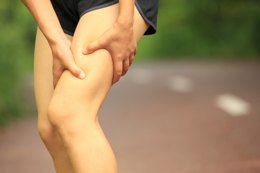To get rid of pain in upper thigh, one must identify the underlying cause that has led to it. In this article, you will get some useful information on the factors that can cause this condition.

The intensity of thigh pain can vary from mild to severe. Usually, when the muscles, tendons, joints or the bones present in the area around pelvis get affected, pain is experienced in the upper part of the thigh. It may get triggered after some rigorous physical activities or because of some diseases that leads to degeneration of the bones and muscles with the increase in age.
Causes
Muscle Pull in Groin
This is experienced in the inner part of the thigh. It happens when a particular muscle becomes taut. This is known as abductor muscle and it helps us in maintaining the natural motion of the toes while running. If you are running on a slippery surface, then the abductors tend to get strained in order to keep the body balanced. Any kind of foot imbalance is another reason for getting a groin pull.
Hamstring Pull
The hamstring muscles run from the buttocks to the back of the knee-joint. A hamstring pull often makes it difficult to extend the leg. In some cases, if you touch the back of the thigh, you may find that a lump has formed. Running on a sloping surface can cause pull in the hamstring muscles. Moreover, while running, if the steps are extended beyond the normal range or short strides are taken at a quicker pace, the hamstring muscles get injured. In short, any change in the usual rhythm of running lead to pulled hamstring.
Meralgia Paresthetica
The lateral femoral cutaneous nerve that causes this problem lies in between the thigh and spinal column. Its main function is to provide senses to the thigh skin. The painful condition arises when this nerve is pressed due to any kind of swelling or injury in the thigh muscles or ligaments.
Quadriceps Pull
The quadriceps is a group of muscles located at the frontal part of the thigh. They help in extending the legs when the knees are straightened. A pull in these muscles means a sharp pain accompanied by numbness. This kind of pain usually affects only on one side of the thigh. When the pull is severe or tears have developed in the muscle fibers, you may notice signs of bruising or swelling.
Other Causes
Apart from the injuries, other causes include some health problems that occur due to aging. As we grow old, the bones, the spine, the vertebrae disks, cartilage, ligaments wear out and the body joints become weak. This leads to an inflammatory condition known as arthritis. Osteoarthritis is the most common form of arthritis. Sciatica is a problem that arises due to degeneration of the vertebrae disk in the lower back region. The roots of the sciatic nerves lies in the spine. If any of the damaged part of the vertebrae disk puts some extra pressure upon the sensitive sciatic nerve, then it suffers strain and a sharp pain is produced.
People with this condition are mostly advised to take complete rest for some time for the purpose of pain management. In this way, aggravation of the pain can be controlled. Application of ice is also proved to be beneficial as it brings down inflammation. Ice should be applied at least 5-6 times every day. Similarly, heat can also be applied to get a soothing relief provided there is no swelling in them. If all these measures do not make much of a difference to the symptoms, then doctors need to be consulted. They prescribe anti-inflammatory medicines to relieve pain. In case the pain is severe, steroids and muscle relaxants are administered and they give excellent results.
Once the pain subsides, you must do some stretching exercises. These exercises improve blood flow in the region and ensure faster healing of the damaged tissues. Regular exercising will add strength and flexibility and the joints and thus protect them from any further injury.


 The intensity of thigh pain can vary from mild to severe. Usually, when the muscles, tendons, joints or the bones present in the area around pelvis get affected, pain is experienced in the upper part of the thigh. It may get triggered after some rigorous physical activities or because of some diseases that leads to degeneration of the bones and muscles with the increase in age.
The intensity of thigh pain can vary from mild to severe. Usually, when the muscles, tendons, joints or the bones present in the area around pelvis get affected, pain is experienced in the upper part of the thigh. It may get triggered after some rigorous physical activities or because of some diseases that leads to degeneration of the bones and muscles with the increase in age.